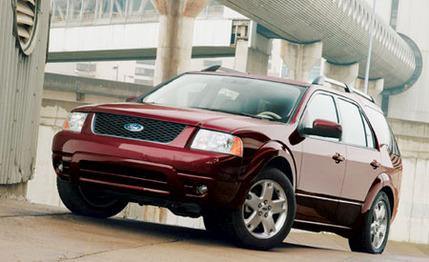
 First Drive Review
First Drive Review
Everyone is fighting for space in this world. Dividing up the available real estate can be hair-pulling work, just ask the Israelis and the Palestinians. Ford Motor Company can't solve this problem, but the company does have a new plan to quell territorial disputes in the family car. The 2005 Ford Freestyle intends to be a mid-size wagon that can host up to seven adults without risking a full-blown intifada. It's a feat some of OPEC's favorite poster trucks can't even do.
The Freestyle finally puts a car-based, standard-three-row SUV in Ford's catalog. The keen brands already have one or are in pursuit. The Buick Rendezvous, the Honda Pilot, and the Chrysler Pacifica are three-row vehicles that accounted for 236,000 sales in 2003. The Toyota Highlander got an optional third row in 2004. Whether it's elevated fuel prices or general SUV fatigue, the buffet line for this type of vehicle is growing with each new entrée. Ford hopes for as many as 120,000 sales next year (the Chicago-built Freestyle arrives at dealers about the time you're reading this).
The Freestyle embarks, along with the 2005 Ford Five Hundred sedan, on a version of the Volvo P2 car platform, giving it tribal ties to the Volvo S60 sedan, V70 wagon, S80 lux liner, and XC90 sport-ute. Ford execs say Volvo provided "design inspiration," which means the optional all-wheel-drive system, which is shipped directly from Sweden, is the only common part worth talking about. Ford engineers fed the Volvo blueprint into their computers and digitally pulled, pushed, bent, stretched, and noodled until it produced the vehicle they wanted, with more space for people and cargo at less cost.
Behind the third-row seats, which fold and swivel flat into the floor in two quick steps, the rear compartment measures 22 cubic feet, or double that of a Volvo XC90. The second and third rows have more cubic feet than a Lincoln Aviator's. Flip forward the Freestyle's second row, and gaining the third is an easy scramble. Head and knee room in back are generous. To make it happen, the seat rows are all shifted forward. The driver and the front passenger pay the price; their toe boards get pinched by the intruding wheel wells. Adjustable pedals are an option.
Compared with other car-conjured wagonoids you've seen, such as the Volvo XC90 and Cadillac SRX, the Freestyle is longer, about the same width, and substantially lower to the ground. Ford wanted drivers as short as five feet to comfortably slide sideways behind the wheel, so the Freestyle fairly sucks the pavement relative to other utes. The driver's seat is at a 'tweener height, six inches higher than in a Taurus but about five inches lower than in an Explorer.
To hold the Freestyle's starting price at about $26,000 for the base SE model, engineers hit the delete button on such items as roll stability control, a complex anti-skid system that works individual brakes to prevent rollovers. Ford also spurned fancy materials for a plain-grain plastic interior. Some gadgets remain as options, including curtain airbags and a Haldex all-wheel-drive unit. The latter transfers torque to the rear axle with an electric pump that hydraulically engages a clutch pack when the computer detects slip. No buttons or knobs involved-just fast traction when it's needed.
Standard equipment across the line includes the fold-flat third row, captain's chairs in the middle row with fold-forward seatbacks that create a flat floor, traction control, ABS, air conditioning, a CD player, roof rails, and two-tone cladding. The mid-trim SEL adds some comfort items plus a six-CD in-dash changer and 17-inch alloy wheels with Continental all-season tires. The Limited model plushes it up with leather front and middle seats, dual-zone climate control, fancier electronics, faux-wood trim, monochromatic paint, and 18-inch wheels wearing stickier Pirelli P6 all-season tires. Stand-alone options for all trim levels include all-wheel drive (about $1700, says Ford), a 50/50 split-folding third row, a sunroof, a middle-row bench for seven-passenger capacity, and an object-sensing backup alarm. Expect fully loaded Freestyles to trade in the low-to-mid-30s.
Ford believes target buyers won't be tire burners, so it's going light on power. Featherweight, in fact. The Duratec DOHC 24-valve 3.0-liter V-6 makes just 203 horsepower and 207 pound-feet of torque, a small output considering fully loaded Freestars will weigh more than 4100 pounds. Ford figures it'll mask the engine's limpness with gearing-well, chaining actually-since the continuously variable transmission uses a German pull-chain design similar to those found in Audis.
The transmission varies its ratio by constantly expanding and contracting the two pulleys that the chain turns in. The new unit, developed by a Ford/ZF joint venture and built in Ohio, employs a 6:1 ratio spread that keeps the engine pinned near its 6000-rpm redline for any urgent work. A brief spin around a Ford proving ground near Detroit revealed adequate if not exuberant acceleration, accompanied by the muted roar of an engine having its figurative neck wrung. Ford expects 20/27 mpg on the city/highway cycles for the front-drive Freestyle and 19/24 for all-wheel drive. Towing capacity is a scant 2000 pounds.
The Freestyle was happier on the twisty handling course, where the front struts and rear multilinks, in essence a Volvo carry-over, cut a straight and stable path. The best cornering is supplied by the Limited with its 18-inch Pirelli rubber, but expect its ride to suffer.
If a slightly choppy ride is the worst gripe you hear from passengers, consider Ford's work done.